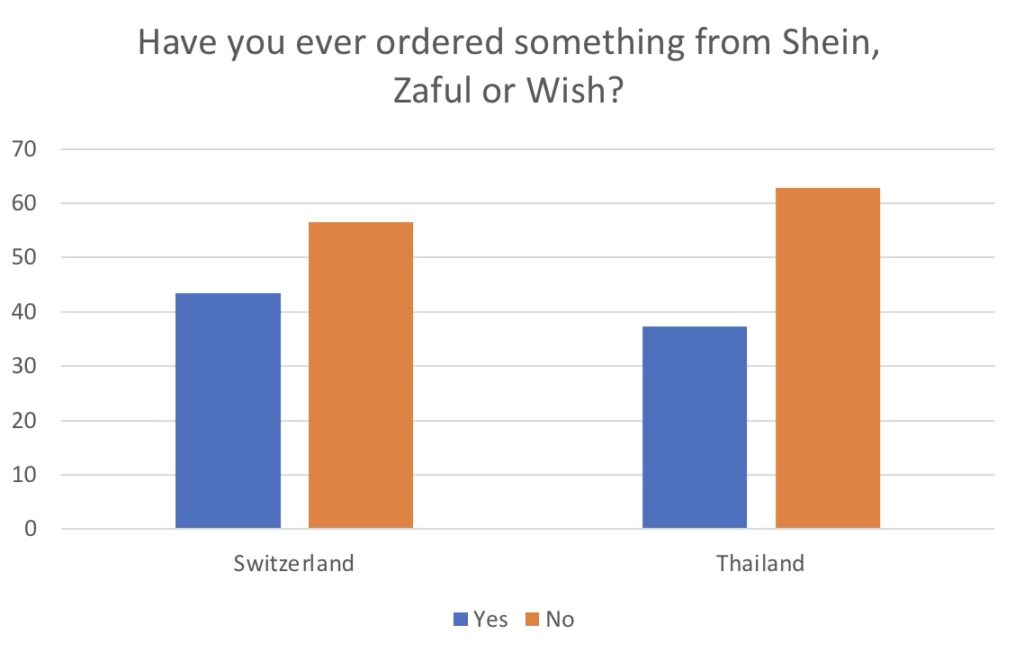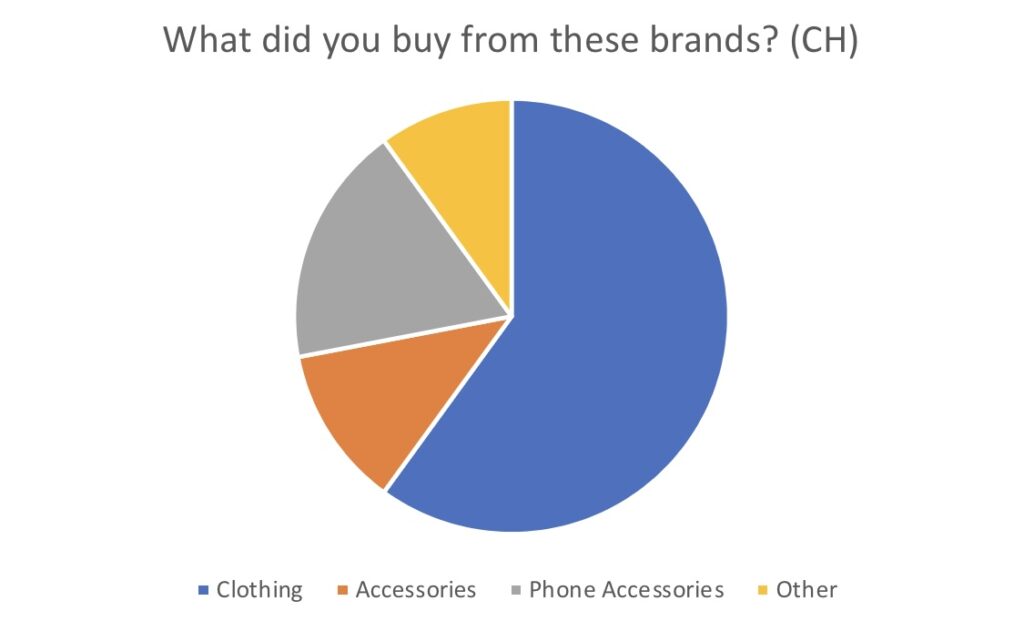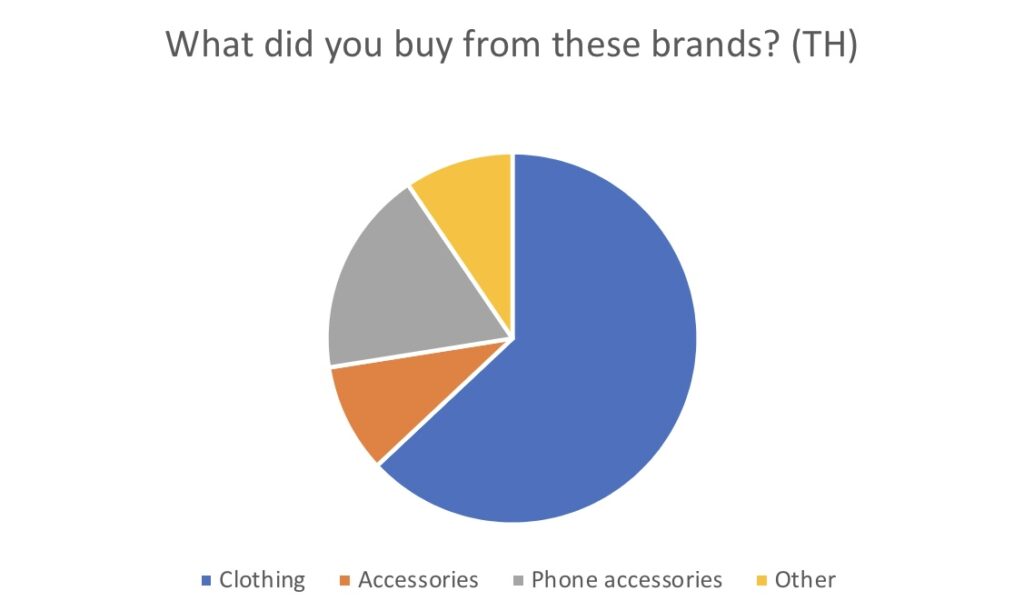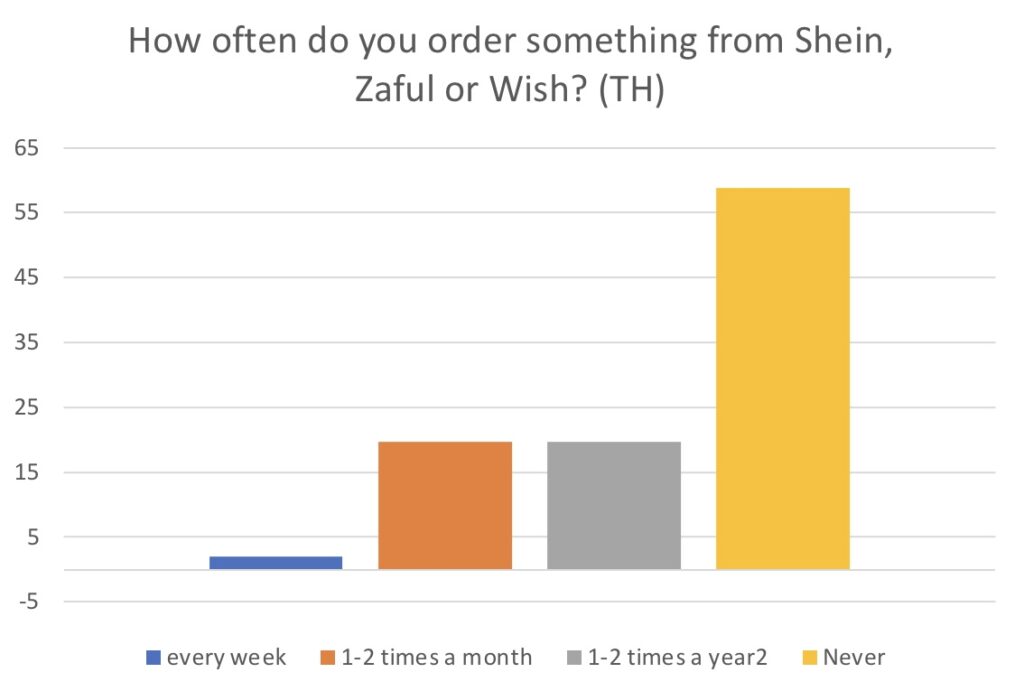Each of us had already had something to do with fashion in some way for example shopping or just looking at fashion posts. What about Fast-Fashion though, ever heard of it? Chances that the term is foreign to you are high, but it quickly becomes clear what it’s all about.
Our Project
In our project we would like to find out what differences or similarities there are in the topic of Fast-Fashion between two different countries. In this topic, we refer exclusively to online Fast-Fashion platforms as Shein or Zaful. Of course, other brands also carry Fast-Fashion, for example H&M, Zara or Forever21 but these do not belong to our project.
For this comparison we took Switzerland and Thailand. Not only is the language fundamentally different, but also the culture itself. Do people in Asia use Fast-Fashion the same way as people in Europe do? Where are the differences and how can they be explained? Through researches and a survey, we want to evaluate this and find an answer.
Why Switzerland and Thailand?
Since we (Kim Lea Hess and Jasmin Runge) have been living our whole life in Switzerland, it was quiet an ease to choose the first country for a comparison. Now, what about Thailand? Well, Jasmin is half Thai and therefore has relatives in the Southeast Asian country, our choice for the second country was Thailand.


Collaboration
Our partner is Pacharadanai Brunold, our same aged friend. Pacharadanai is currently in Thailand and is working with us from there. He will take a closer look at the situation in Thailand and give us updates.

What is Fast-Fashion?
Fast-Fashion describes the cheap making and selling of clothing. Primarily, trends are followed and produced within a very short time and sold in quantities. The original idea was that customers would save more money to buy even more stuff. Typical Fast-Fashion brands are for example H&M, Zara, Forever 21, but also online shopping sites like Zaful, Shein or Wish.
What is the origin of Fast-Fashion?
Fast-Fashion developed between the 60-ies and the 80-ies. Previously, the cost of production was still very expensive, whereas with the industrial revolution they could produce more and faster. Fashion has evolved from local and traditional craftsmanship to global mass production with standard sizes. Younger people began to express themselves more and more with the clothes which was not yet common at that time.
Problems with Fast-Fashion
At first glance, the deal does sound good. The average customer can buy trendy fashion at a cheap price. From the catwalk to the closet. But this is exactly where the problem lies. It is quickly overlooked, even though it is so obvious. Not only is our environment being harmed, but the human rights of workers are also being trampled underfoot. According to a 2019 study by the EU Parliament, the textile industry causes an average of 1.7 billion tons of climate-damaging CO2 per year worldwide – more than is emitted by aviation and shipping.
Example with Shein
Shein is one of the most popular brands and is praised for its trendy clothes and affordable prices. What people tend to forget about Shein is that they obviously steal styles from designers, pay their workers below living conditions and produce a huge amount of waste. Every day, about 6,000 new styles are posted on the website. No one can say that this can be sustainable.
Shein makes it very difficult to find out about their work and conditions, and not only does Shein lack evidence to prove otherwise, but a recent investigation has proven that the working conditions are terrible, with factory workers having to work up to 75 hours a week!
Heres the link to the investigation. [1]

© Panos Pictures / Public Eye [1]
Fast-Fashion pollutes the environment more than air travel
More and more people are looking to minimize their carbon footprint. For example, they are deciding against air travel and no longer take the car to work, preferring instead to take the bus or train. However, hardly anyone wants to do that with the latest fashion trends. Even though the textile industry releases 1.2 trillion tons of CO2 every year – more than international air travel and shipping combined!
According to an article published in the journal Nature in 2018 around 60 percent more items of clothing were purchased in 2018 than in 2000. If there is no rethink, the consumption of resources will triple by 2050. [2]
Much of the clothing manufacturing takes place in China and India, countries that rely on coal-fired power plants, increasing the carbon footprint of each garment. About 10 percent of total global emissions come from the fashion industry.
Many textile factories dump toxic chemicals into rivers and are responsible for some of the most polluted waters in the world.
Observation and Interview

There, Pacharadanai approached some strangers and asked what their general opinion is about online shopping since we first want to know what Thais in general think about it before we go further into detail. Unfortunately they weren’t comfortable with being recorded and also haven’t had a lot of time, so Pacharadanai recreated their answers in an audio for us.
Audio 1 :
They prefer to shop in stores and not online. They are not sure about the quality after all. Also, there are always additional delivery problems. When you shop in the store, you already have your piece of clothing safe and know what you really bought.
Audio 2:
They prefer to shop online because they don’t have to go out of the house. It’s much easier and more cozy. The internet has much more offers than a shopping mall and in the worst case they send it back. Delivery is good most of the time.
Online shopping behavior
To get an idea of how online shopping is generally handled in each country, we did some research and also asked our families in Switzerland and Thailand.
We eventually have come to the conclusion that both countries have increased their online shopping activity. It actually has become to an everyday thing.
Thailand online shopping behavior
We came across a statistic [3] which shows that older people shop online more often. This was actually surprisingly. More and more people are getting carried away with online shopping, so the spending on e-commerce has doubled from 2017 to 2019 and it is expected to increase steadily. The ESW data also shows further future trends.
Switzerland online shopping behavior
Switzerland does not fare badly either. The study [4] we found reports that 87 percent of Swiss people make purchases online every month. No wonder with online sites like Tutti.ch, Scout24.ch and other forums.
With this clarified we can now go a step further and talk about the consume of Fast-Fashion
Survey evaluations
Following there are evaluation graphics of the survey. This survey is to help us get an idea of how things are, it cannot be used for any other purpose. 50 people from Thailand and 80 people from Switzerland participated in this survey. We sent these out with a link to different Whatsapp groups to get our results.
Here are the links to the surveys if you are interested:
Thai Survey (Kobotoolbox)
Swiss Survey (Kobotoolbox)








What can we conclude out of these results? As far as we can tell, there are no major differences between Thailand and Switzerland. Fast-Fashion is consumed just as much. But how can it be that Thailand and Switzerland got almost the same results, even though they have so little to do with each other?
It’s simple, the Internet and the globalization that comes with it have made our world much more open. Many trends are not only practiced in one country, but worldwide. Communication between each other is much easier now, so things spread much more easily and lead to many countries having similar brands, trends and products.
…so how can we stop Fast-Fashion?
First thing to do: inform your surroundings! Be it your close friends, family members or your Instagram followers, it doesn’t matter just inform them about the truth behind fast fashion and how damaging it is for our environment and our future.
Now following you have some tips how to fight against Fast-Fashion:
- Shop from sustainable and ethical fashion brands. It seems so obvious, but many people tend to overlook it.
- Buy less often and buy high quality.
- Shop second hand.
- Recycle your old clothes.
We are open to suggestions for improvement, criticism or a simply nice comment.
Interactive learning tool
We made a fun interactive learning tool where you can learn some key words referring to Fast-Fashion.
You can download the Powerpoint with the link below.
Fast-Fashion Keywords
Here you can see a short introduction video to give you an idea on how the whole thing works.
Authors
Kim Lea Hess
Jasmin Runge

Reviewer
Katharina Borgelt
Benjamin Werz
Sources
[1] Toiling away from Shein (publiceye.ch)
[2] The price of Fast-Fashion (nature.com)
[3] Shopping statistic Thailand (ESW.com)
[4] Shopping Study Switzerland (statista.com)
Internal links
Is Upcycling Fashion Fashionable?
The story behind fashion
Let me take you on the journey of textiles
☷ See the project teams here »
☵ Some words about the contributions »
☴ Our sponsors and partners » (the-horse.education)

I really enjoyed reading your article.
Especially the fact that you chose ro compare two countries i found very interesting. Also the charts really helped to get a „simplified“ insight on numbers.
Thank you
The topic is really good and how the authors put it into words. The comparison with another country that is known for the production was really fascinating and how we are so alike even though we are miles apart. I could learn a lot from all the graphics an statistics and reading was enjoyable. In my opinion people could do more to protect the earth and i will definitely take action from now on and improve my behaviour so that i can live more sustainable
The article was really interesting to read an informative.
Fast-Fashion is really damaging and i agree with the autors, that not a lot of people know about it so it would be helpful to educate them in school while they are still young. The images and especially the grafics were convenient since you can see the situations in both countries with just one look. I also enjoyed the audios from Pacharadanai and i think the collaboration was a succes for both teams. The learning tool was very interactive and fun. I am now aware of the problems fast-fashion causes and i will try to improve my behaviour with the tips listed in the article.
Very interesting topic. As someone who used to shop a lot on Wish/Aliexpress etc, this is giving me food for thought now.
The video with the vocabulary for the keywords is awesome – you did a really great job.
Wow, your topic really fascinated and amazed me. Fast fashion harms the environment, the workers in the garment industry, the animals and ultimately the consumer’s wallet. But nowadays, unfortunately, we don’t think that far ahead when we absolutely want the garment.